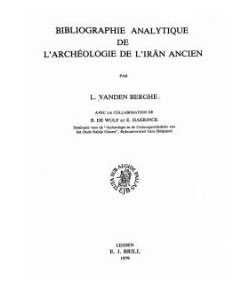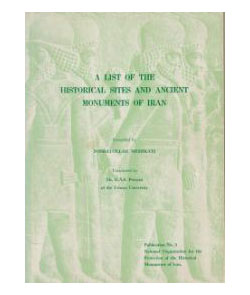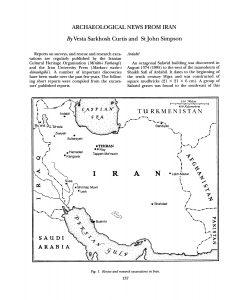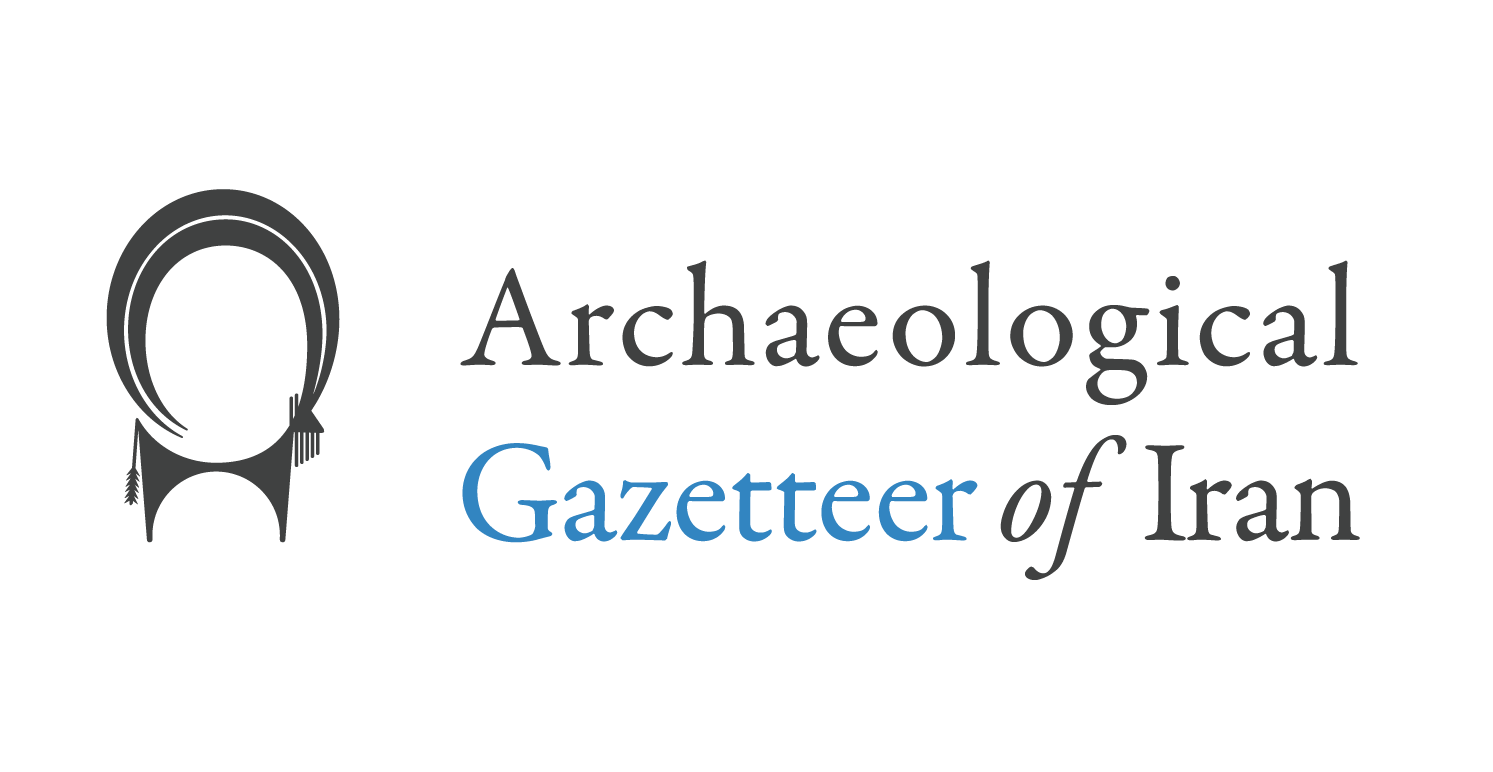Introduction
Iran is one of the major constituent regions of the ancient world, located in southwest Asia, between the Indus and the Tigris rivers. It is bounded to the north by the Central Asian steppes, the Caspian Sea, and the mountains of Caucasus; to the west by the Anatolian Plateau and the plains of Mesopotamia; to the south by the Persian Gulf and the Sea of Oman; and to the east by present-day countries of Pakistan and Afghanistan. Iran is estimated to have over 300,000 archaeological sites, dating from the Old Stone Age to medieval times. These sites range from prehistoric caves, shelters, and campsites to highly complex monuments and cities. The archaeological exploration of the country began as early as the seventeenth century and led to the formation of archaeological institutions and the creation of Iranian archaeology disciplines and curricula in Iran, Europe, and North America.

Sixty years have passed since Louis Vanden Berghe (1923-1993), the celebrated Belgian archaeologist, published his magnum opus, Archéologie de l’Iran Ancien (Leiden, 1959). For years, Vanden Berghe’s book was an indispensable source for the study of Iranian archaeology. He soon realized, however, that the on-going research and fieldwork would eventually make his work obsolete. He thus began to publish a series of analytical bibliographies known as Bibliographie analytique de l’archéologie de l’Iran Ancien (Leiden, 1979) followed by four supplements with the last one published by his former student and successor, Ernie Haerinck (1949-2016), in 2013. However, the rising number of new discoveries and excavations made it almost impossible to keep up with the current  research developments in the form of printed bibliographies. Besides, the scope of the Bibliographie analytique de l’archéologie de l’Iran Ancien was restricted both chronologically (covering the Pre-Islamic periods only) and linguistically because it excluded the publications in Persian, as Vanden Berghe explains in the preface to his Bibliography analytique: “Persian language publications have not been listed because a bibliography of works published by Iranian authors is being prepared in Tehran.” But, such a bibliography of publications in Persian never came out! The lacunae was partially filled by Haerinck who attempted to include those archaeological reports in Persian which had an abstract in English.
research developments in the form of printed bibliographies. Besides, the scope of the Bibliographie analytique de l’archéologie de l’Iran Ancien was restricted both chronologically (covering the Pre-Islamic periods only) and linguistically because it excluded the publications in Persian, as Vanden Berghe explains in the preface to his Bibliography analytique: “Persian language publications have not been listed because a bibliography of works published by Iranian authors is being prepared in Tehran.” But, such a bibliography of publications in Persian never came out! The lacunae was partially filled by Haerinck who attempted to include those archaeological reports in Persian which had an abstract in English.

Work on compiling a preliminary list of archaeological sites and monuments in Iran in the form of a gazetteer was begun by Nosratollah Meshkati (1908-1979), an Iranian archaeologist and the former Director General of the Iranian Archaeology Department. In 1966, Meshkati published an inventory of 531 archaeological mounds and monuments organized into categories such as palaces, fire temples, mausolea, mosques, bridges, caravanserais, bridges, etc. (Fehrest-e banāhā-ye tārikhi va amāken-e bāstāni-ye Iran, Tehran, Sāzmān-e melli-ye Hefāzat-e Āsār-e Bāstāni, 1345/1966, translated into English as A List of Historical Sites and Ancient Monuments of Iran, National Organization for the Protection of the Historical Monuments of Iran, Tehran, 1970). The List gives a brief account of each site or monument illustrated with photographs, including the relevant National Registration number. Meshkati’s book was designed as a working reference guide to provide “a list of edifices classified as historical monuments, together with the sites in the same category, and to keep an up-to-date inventory of these in the Directorate General of Archaeology of the Ministry of Culture and Arts.” Unfortunately, the List was never kept up-to-date, and the location of Meshkati’s flashcards and archival papers is unknown.

The third attempt to create a reliable record of archaeological fieldwork in Iran began in 1967, when David Stronach, then Director of the British Institute of Persian Studies in Iran, decided to include the section Survey of Excavations in Iran in the Institute’s journal, Iran. The fieldwork directors sent a brief report of their activities to the journal on an annual basis. Then, the reports were assembled, arranged, and presented in the journal in three languages, English, French,  and German. The Survey of Excavations has since become an essential source of information for the fieldwork carried out in Iran between 1965 and 1978 (with the last one published in Iran, vol. 17, 1979). In 1997, at the initiative of Vesta Sarkhosh-Curtis and St John Simpson, the journal resumed the limited, occasional publication of archaeological fieldwork in Iran under such sections as Archaeological News from Iran, Archaeological News from Iran and Central Asia, and Archaeological Reports. The section had a short life and disappeared after a few years.
and German. The Survey of Excavations has since become an essential source of information for the fieldwork carried out in Iran between 1965 and 1978 (with the last one published in Iran, vol. 17, 1979). In 1997, at the initiative of Vesta Sarkhosh-Curtis and St John Simpson, the journal resumed the limited, occasional publication of archaeological fieldwork in Iran under such sections as Archaeological News from Iran, Archaeological News from Iran and Central Asia, and Archaeological Reports. The section had a short life and disappeared after a few years.
The number of archaeological activities in Iran has remarkably increased in the past thirty years, including the discovery of some important sites and artifacts, to the point that no printed publication is able to absorb and present such a growing volume of information. The continuing archaeological developments have led to the accumulation of hundreds of records that are largely in the form of published volumes mainly in Persian, pamphlets, printed internal memos, unpublished reports, and photographs. The Archaeological Gazetteer of Iran would allow to capture and convert these important scattered threads of data into an organized, open-access research tool, and to present them to the specialized and interested audience through a dedicated website, thereby contributing to the visibility of current research and developments in both Iranian archaeology and in the archaeology of ancient Near East. The Gazetteer is intended to cover all Iranian archaeological sites regardless of the present-day political borders of the country, thus expanding its functionality to adjacent regions such as Mesopotamia, Anatolia, and Transoxiana.
The Gazetteer is a site-based encyclopedia in which archaeological places are plotted on an interactive map. The entries present a comprehensive, updated record of sites, including illustrations and references. The Gazetteer will also incorporate, digitize, and present rare and less accessible publications and reports, particularly those in Persian. Institutional libraries in North America and Europe infrequently receive such publications, making most of the archaeological reports in Persian inaccessible or unknown to scholars. The Gazetteer is also a living database. Its content is regularly improved and updated according to the most recent archaeological studies in the Iranian World.
The Archaeological Gazetteer of Iran is a research tool for scholars in all branches of humanities, including anthropology, art history, and history, but more specifically for those working on the archaeology of Iran and the ancient Near East. The Gazetteer is a free, open access resource and will be hosted and maintained by the University of California, Los Angeles, which will ensure its up-to-date, long-term use and availability.

